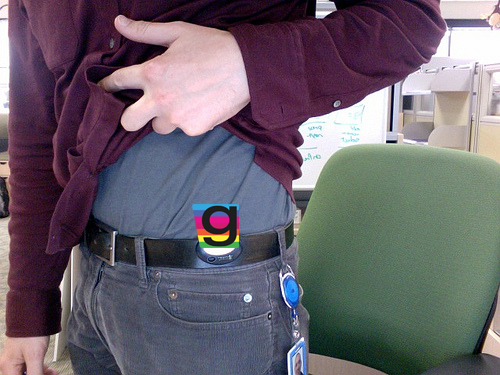
Edit – Zamzee replied to some our questions below!
I may have doubts about the Nike Fuelband being a viable device to increase physical activity but some new research from Zamzee could prove me otherwise. A randomized-control study sponsored by HopeLab and the Robert Wood Johnson Foundation was conducted to demonstrate the effectiveness of the Zamzee device with and without their motivational website. 448 U.S. middle school students in rural, urban, and suburban schools were given Zamzee devices. Half of the students had access to the Zamzee’s motivational website and the other half could only access the data uploaded by the Zamzee device.
After 6 months of monitoring, the results showed that the students who had access to Zamzee’s motivational website had 59% more physical activity than the control group. HopeLab approximates that number to be about an extra 45 minutes of moderate to physical activity per day or in other words: the equivalent of doing 45 minutes of nonstop pushups per week. New data about the efficacy of gamifying daily physical activity is very exciting but I have some qualms about the information presented.
Study Findings:
It is a significant factor that the students’ physical activity was purely assessed by the data generated by the Zamzee device. Three-axis accelerometers are not perfect and they are present in both the Fuelband and Zamzee. It isn’t certain whether or not the same technologies exist within each device but it is easy to fool an accelerometer into recording physical movement and interpreting that as actual physical activity. The study is also supposed to be a randomized-control study but both groups received the Zamzee device so I am uncertain how simply having the Zamzee affected physical movement among the students. Those students who had access to the motivational website could have been motivated to earn more points using their accelerometers to win more prizes. The final thing to note is that, while the data shows better management of blood sugar and cholesterol, there is no explanation why the control groups were each demonstrating increases in LDL cholesterol and HbA1c levels. Given that relative age of each child was 11 – 14 and had a mean BMI of 22.2 (Healthy level), that doesn’t speak towards a trend of those increased levels.
Maybe I’m bitter about the Fuelband’s ineffectiveness in my life but it is important to have really solid data about these devices so that we really do know they work. Perhaps if the Fuelband gave me some angry bird plushies and cash I’d be just as motivated.
via ZamzeeBlog
—
Zamzee was very quick to respond to my questions about their research. Here’s what Richard Tate, VP, Communications & Marketing at HopeLab/Zamzee had to say (marked as RT):
“It is a significant factor that the students’ physical activity was purely assessed by the data generated by the Zamzee device. Three-axis accelerometers are not perfect and they are present in both the Fuelband and Zamzee. It isn’t certain whether or not the same technologies exist within each device but it is easy to fool an accelerometer into recording physical movement and interpreting that as actual physical activity.”
[RT] The Zamzee activity meter tracks most movement, but the study results focus on recorded activity that meets a certain threshold of intensity – specifically, moderate to vigorous physical activity (MVPA). For example, walking quickly with your Zamzee meter might meet the threshold; jogging definitely would. As for “fooling” the device, repetitive, mechanical movements – like, say, clipping your Zamzee to a ceiling fan – typically don’t meet the threshold for MVPA. But clipping a Zamzee to your little brother while he runs around the house might! It’s true that accelerometer technology isn’t perfect. That said, we’ve spent quite a bit of time refining the way recorded movement data is analyzed in order to study Zamzee’s real impact on physical activity levels.
“The study is also supposed to be a randomized-control study but both groups received the Zamzee device so I am uncertain how simply having the Zamzee affected physical movement among the students. Those students who had access to the motivational website could have been motivated to earn more points using their accelerometers to win more prizes.”
[RT] Both groups received Zamzee meters so that we could compare recorded physical activity levels between the two groups, using the same objective measurement tool. Half of the kids in the study were randomly assigned to receive only the activity meter, with no other rewards/incentives, to establish a baseline of “typical” activity levels in the random sampling of kids (the control group); the other half received the activity meter and had access to the motivational website and its related rewards and incentives (the active group). This is a standard randomized controlled study design.
To your uncertainty about how having a Zamzee impacts activity, it’s reasonable to assume – and other research has shown – that when you know your behavior is being monitored (e.g. recording how much you move with a Zamzee), you tend to behave differently. So the control group (the kids with just the Zamzee meter) may indeed have been more activity as a result of carrying the device. But a study evaluating that impact alone would not generate new or novel insights beyond what previous research has already shown. We were interested in understanding how gamification in a motivational website experience might boost physical activity levels even further than simple monitoring. Because both groups in the study had Zamzee activity meters, the effect of simply being monitored becomes a moot point because we see in the data a significant difference in the level of physical activity among the active group (the kids with access to the motivational site) over the control group. That difference indicates that the gamified motivational Zamzee website increased physical activity by 59% on average over 6 months relative to the control group (activity monitoring alone). So yes, the group with access to the site were motivated to earn more points using their accelerometers to win more prizes – when well applied, gamification works!
“The final thing to note is that, while the data shows better management of blood sugar and cholesterol, there is no explanation why the control groups were each demonstrating increases in LDL cholesterol and HbA1c levels. Given that relative age of each child was 11 – 14 and had a mean BMI of 22.2 (Healthy level), that doesn’t speak towards a trend of those increased levels.”
[RT] I’m not sure I understand the last sentence, but generally it’s important to remember that kids in this age range are growing. A lot! So increases in these biomarker levels is not necessarily unhealthy. However, over time, we know that these types of increases (when not attributable to healthy growth) are the risk factors for major health problems, like heart disease and type 2 diabetes. The data in the study show that using Zamzee helped control these risk factors, even if they were in a healthy range for this population.
Big Kudos to Richard and the Zamzee team for quickly reaching out to me to clarify some of the questions I had about the research. I’m a little cynical by nature but what Zamzee is doing is backed by research and ultimately to the benefit of middleschoolers who need it the most.
My next request for Zamzee is to test out its effectiveness strictly on children who have a BMI over 30. In an ideal world, I would have this study done separately in an urban environment and in a rural environment to see differences in population and physical activity levels.
Either way, Zamzee is working on a product they care about – and it shows!









Hi Ivan. Thanks for your post. We’d love to talk with you further to clarify your questions about the Zamzee research results. Can you please email nina@zamzee.com to set up a phone call? Thanks! /Nina
Always needing to watch for “gaming the game” tactics, I love the recognition that someone might cheat by clipping the device to their little brother.